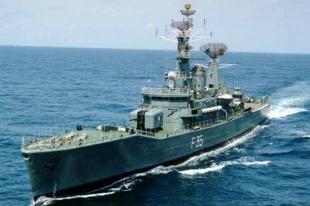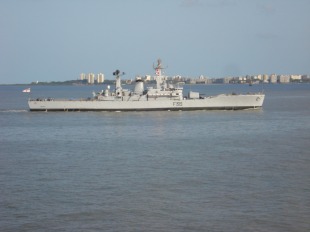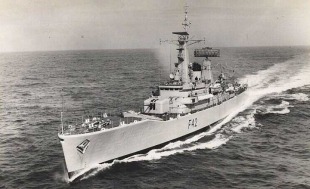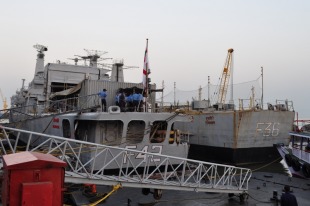Nilgiri-class frigate (1972)
Basic information
Ship measurements
Machine
2 * 550 psi (3,800 kPa) boilers2 * 30,000 hp motors2 * shafts
Personnel
Combat assets
- Signaal DA05 / BEL PFN513 radar
- Signaal LW08 / BEL RAWL02 surface radar
- Signaal ZW06 / BEL RASHMI navigation radar
- Signaal M-45 navigation radar
- Westinghouse SQS-505 / Graesby 750 sonar
- Type 170 active attack sonar
- 2 * MK.6 Vickers 115mm guns
- 2 * AK-630 6-barreled 30 mm gatling guns
- 2 * Oerlikon 20mm guns
- 2 * triple ILAS 3 324 mm torpedo tubes with Whitehead A244S or the Indian NST-58 torpedoes
1 * Westland Sea King or 1 * HAL Chetak
The Nilgiri-class frigates were updated versions of the Leander class, designed and built for the Indian Navy by Mazagon Dock Limited in Mumbai. Six ships were built between 1972–81. Vessels of the class formed the 14th Frigate Squadron. The lead ship INS Nilgiri was the first major warship to be built in India in collaboration with Yarrow Shipbuilders of the United Kingdom.
The class and its lead ship, INS Nilgiri are named for the Nilgiri Hills. Subsequent ships in the class are also named for hill ranges of India.
When the British refused to provide license production of the radar suite, the Indian Navy teamed up with Signaal of Netherlands to license-build a similar radar search, tracking and fire control suite in India, which went into the latter five ships. Improved versions of the Signaal search radar continues to be fitted in later classes of Indian Navy ships. The last two ships, INS Vindhyagiri and INS Taragiri were modified significantly with the addition of a Sea King ASW helicopter, a collapsible Canadian hangar, ILAS 324 mm triple torpedo tubes and a Bofors ASW twin barrel mortar. This re-design was done indigenously by the Indian Navy and gave it much needed experience and confidence in ship-design and modification. They were also fitted with an indigenous ASW fire control action information system which was a first for the Indian electronics industry. This project was led by the late Captain (later Rear Admiral) Prakash N Gour. The British categorically refused to extend their design warranty to the Indian modifications which nevertheless proved to be a success.
The Nilgiri class has been decommissioned by the navy, with the entry into service of the Shivalik-class. Five ships have been decommissioned and one sunk in an accident. INS Taragiri was the last ship of the class to be decommissioned, on 27 June 2013 in Mumbai, after serving 33 years in the navy.
- Comments
 en
en ru
ru uk
uk




 Indian Navy
Indian Navy Mazagon Dock Shipbuilders Limited (MDL)
Mazagon Dock Shipbuilders Limited (MDL)